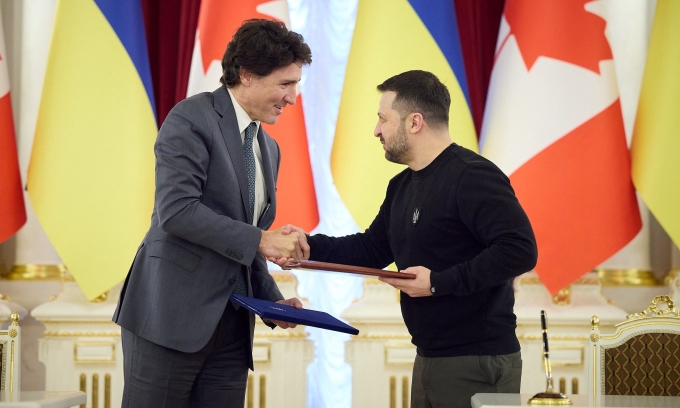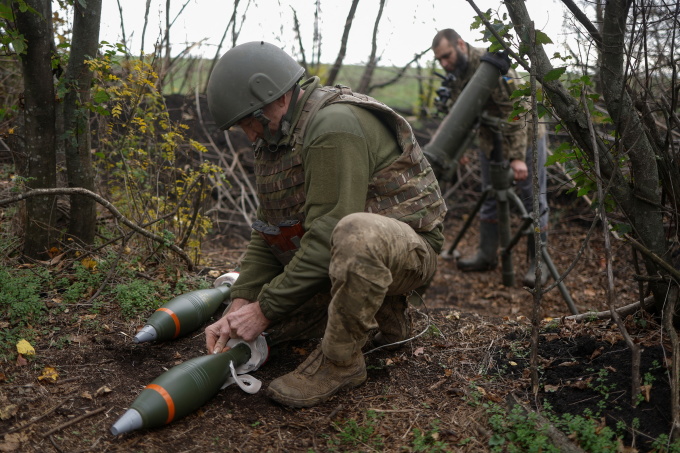As the $60 billion US aid package continues to stall, Ukraine is scrambling to find alternative funding to sustain its war with Russia.
Ukraine has allocated nearly half of its $87 billion budget this year to defense, but its domestic revenues are just $46 billion, meaning Kiev will need help from foreign allies and partners to plug its budget deficit as the fighting drags on.
The deficit could widen even further after Ukraine plans to mobilize 500,000 new soldiers, with billions of dollars to pay for their salaries, training and equipment.
“We have almost exhausted our capabilities. All internal resources have been used to finance the army,” said Roksolana Pidlasa, chairwoman of the Ukrainian parliament’s budget committee.
Ukraine’s Plan A is that financial and military aid from the US and the European Union (EU) will begin arriving in January. The EU’s four-year, $54 billion financial aid package for Ukraine was only approved in February, after a block from Hungary. The delay means Kiev must start looking at Plan B and even Plan C, Pidlasa said.
" The government is in talks to seek aid from other G7 countries, especially Japan and Canada. We are also considering the possibility of cutting non-military spending and raising taxes," she said.

Ukrainian President Volodymyr Zelensky (right) and Canadian Prime Minister Justin Trudeau in Kiev on February 24. Photo: Reuters
President Volodymyr Zelensky said last month that if the US Congress does not approve a $60 billion aid package in the coming weeks, “our position on the battlefield will weaken.” A bipartisan effort to break the deadlock is underway in Washington, though chances appear slim as Republican frontrunner Donald Trump opposes further aid to Ukraine.
Senior US intelligence officials have warned that without additional US aid, Ukraine faces the prospect of continued battlefield losses. They predict that any delay in US aid could result in Russia gaining more territory in the coming year.
In more than two hours of testimony before the Senate Intelligence Committee, CIA Director William Burns and Director of National Intelligence Avril Haines described an increasingly dire situation for Ukraine. Russia is producing more artillery shells and has found a steady supply of drones, artillery shells and other military equipment.
“It is hard to imagine how Ukraine can sustain the incredibly difficult advances it has made against the Russians,” Haines said.
Mr Burns, who recently returned from his 10th visit to Ukraine, said the war was at a critical juncture for both European security and US interests around the world. If the House of Representatives passes the new aid package, Ukraine could strike a strategic blow against Russia, he said.
“We assess that with additional support, Ukraine can hold its ground on the front lines through 2024 and early 2025. They can continue to make Russia pay not only with attacks on the Crimean peninsula but also targeting the opponent’s Black Sea Fleet,” he said.
Pidlasa said Ukraine is stepping up diplomatic efforts to convince the US to approve the aid package. But Ukraine is also preparing for similar difficulties next year. The US budget process for the new year begins in October, a month before the presidential election.
“So it could be a similar situation to what we saw this year,” a senior Ukrainian official said.
In addition to this year’s defense budget, Ukrainian officials have warned that the mobilization of about 500,000 new soldiers will cost about $8.6 billion. Last month, the Ukrainian military requested $12.4 billion for additional equipment to fill the gap from the United States and ensure funding for the mobilization.
Since the conflict began in late February 2022, Kiev has spent nearly all of its domestic revenues on training, equipping and paying its soldiers. For the rest of its expenses, Ukraine has had to rely on aid from the West.
Budget support from the US, the International Monetary Fund (IMF), the EU and the World Bank can only be used for non-military spending such as paying civil servants' salaries and pensions.
Ukraine has only secured half of the $37 billion in aid it needs this year, pledged by the EU and the IMF, according to the Ukrainian Finance Ministry. This month, Kiev expects to receive about $4.9 billion in aid from the EU and more than $2.5 billion from the IMF, Japan, the UK and Canada. In the first two months of the year, Ukraine received $1.2 billion in grants and concessional loans from Japan, Norway and Spain.
To reduce the budget deficit, the Ukrainian government has taxed bank profits, raising $3.7 billion this year, according to the Finance Ministry.
Spending cuts, privatization, tax increases and even printing money are among the options being considered by the Ukrainian government, according to Pidlasa. But she added that “most of these options will be unpopular.”
Ukrainian politicians are also considering introducing a “reserve system”, where Ukrainian men could pay a sum of money to avoid military service. However, Ms Pidlasa said this was a political decision and not part of a budget calculation.
While Ukraine can raise revenue to finance its military, its stockpiles of US ammunition and weapons, such as Patriot air defense systems, are vital to it. A large part of the US $60 billion aid package will fund weapons for Ukraine.

Ukrainian soldiers prepare mortar shells at the front line in Mykolaiv province, Ukraine in October 2022. Photo: Reuters
As US military aid dwindles, the effects are being felt on the battlefield.
The Ukrainian military began complaining of severe ammunition shortages in December, forcing its artillery to limit its fire. Russian forces have not had such problems and have made increasing gains on the eastern front, taking control of the town of Avdeevka and several other villages in Donetsk.
A European effort led by the Czech Republic to urgently procure ammunition for Ukraine has attracted attention in recent weeks. France and Germany have pledged to contribute, but the plan has yet to be finalized.
In addition, the pro-Ukrainian alliance in Europe has also seen cracks in the supply of weapons. Germany has faced criticism for refusing to supply long-range Taurus missiles to Ukraine.
"There are a lot of contradictions. Germany says they cannot supply Taurus missiles, but Britain and France can supply long-range Storm Shadow and Scalp missiles," said Glib Buriak, a professor at the Ukrainian-American Concordia University in Kiev.
Ukraine’s leaders have rejected proposals to follow Russia’s wartime economic model, arguing that more than half of the country’s economic output is in the service sector and that much of its industrial base was dismantled after the collapse of the Soviet Union or destroyed in the war.
“If we mobilize everyone to work for the military manufacturing industry, who will pay for the shipments of artillery shells and other military equipment? Someone needs to pay taxes,” Pidlasa said.
Ukraine’s economy ministry is looking to boost domestic production and last month announced $1.1 billion in grants and loans to stimulate production and attract investment. However, Mr Zelensky stressed that the support was only available to businesses that paid taxes.
“Taxes are weapons. Before the conflict, half of the economy was evading taxes,” said Danylo Hetmanstev, head of Ukraine’s parliamentary tax committee, adding that tax revenues had increased by 12.4% in February compared to the previous 12 months.
Thanh Tam (According to FT, Reuters, AFP )
Source link



























![[Photo] National Assembly Chairman Tran Thanh Man visits Vietnamese Heroic Mother Ta Thi Tran](https://vphoto.vietnam.vn/thumb/1200x675/vietnam/resource/IMAGE/2025/7/20/765c0bd057dd44ad83ab89fe0255b783)








































































Comment (0)